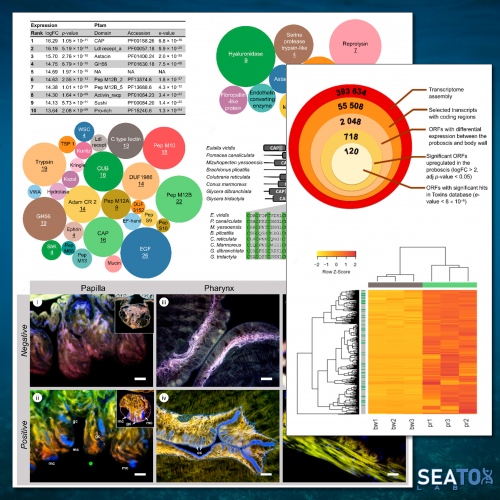WormALL
Welcome to the Project WormALL website!
WormALL - Marine invertebrates as source of novel biotoxins: Investigating function and application through Polychaeta venomics
Funded by Fundação para a Ciência e Tecnologia (Portugal), reference PTDC/BTA-BTA/28650/2017
Period of implementation: 01-10-2018 to 30-09-2022. WormALL is now foreclosed!
Brief description
Even though the oceans may offer an almost inexhaustible source of animal biotoxins, whose value for research and biomedical applications is undisputable, the lack of integrated research to discover, isolate and characterise new marine biotoxins is delaying their added value to Biotechnology. The present application aims at developing a comprehensive strategy to unravel marine invertebrate biotoxins upon lessons learned from the Polychaeta, which form a diverse and abundant taxon that has been neglected albeit recent findings showing an unexpected variety of entirely novel peptidic biotoxins. The project is a tiered approach that combines expeditious in vivo and in vitro toxicity testing of harvested and isolated toxins (e.g. from secreted mucus) with state-of-the-art ‘venomics’ and other tools to disclose the nature, mode-of-action and adaptative value of these toxins in order to build a database for the efficient transfer of knowledge to industry and other societal stakeholders.

Main publications
MOUTINHO CABRAL, I., MADEIRA C., GROSSO, A.R. & COSTA, P.M. (2022). A drug discovery approach based on comparative transcriptomics between two toxin-secreting marine annelids: Glycera alba and Hediste diversicolor. Molecular Omics 18, 731-744 (doi: 10.1039/D2MO00138A).
RODRIGO, A.P., LOPES, A., PEREIRA, R., ANJO, S.I., MANADAS, B., GROSSO, A.R., BAPTISTA, P.V., FERNANDES, A.R. & COSTA, P.M. (2022). Endogenous fluorescent proteins in the mucus of an intertidal Polychaeta: Clues for biotechnology. Marine Drugs 20, 224 (doi: 10.3390/md20040224).
RODRIGO, A.P., GROSSO, A.R., BAPTISTA, P.V., FERNANDES, A.R., & COSTA, P.M. (2021). A transcriptomic approach to the recruitment of venom proteins in a marine annelid. Toxins 13, 97. (doi: 10.3390/toxins13020097)
RODRIGO, A.P., MENDES, V.M., MANADAS, B., GROSSO, A.R., ALVES DE MATOS, A.P., BAPTISTA, P.V., COSTA, P.M., FERNANDES, A.R. (2021). Specific antiproliferative properties of proteinaceous toxin secretions from the marine annelid Eulalia sp. onto ovarian cancer cells. Marine Drugs 19, 31. (doi: 10.3390/md19010031)
D'AMBROSIO, M., SANTOS, A.C., ALEJO-ARMIJO, A., PAROLA, J. & COSTA, P.M. (2020). Light-mediated toxicity of porphyrin-like pigments from a marine polychaeta. Marine Drugs 18, 302. (doi: 10.3390/md18060302)
GONÇALVES, C. & COSTA, P.M. (2020). Histochemical detection of free thiols in glandular cells and tissues of different marine Polychaeta. Histochemistry and Cell Biology 154, 315–325. (doi: 10.1007/s00418-020-01889-3)

